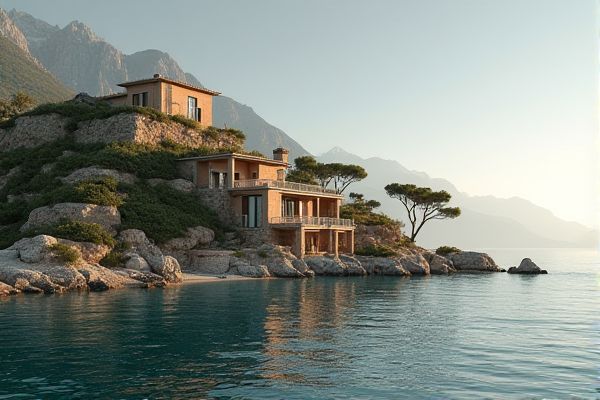
A peninsula is a landform surrounded by water on three sides but connected to the mainland, offering unique access to both land and sea environments, while an island is completely surrounded by water, often fostering isolated ecosystems. Explore the distinctions and characteristics of these landforms to better understand your geographic knowledge.
Table of Comparison
| Feature | Peninsula | Island |
|---|---|---|
| Definition | Land surrounded by water on three sides connected to mainland | Land completely surrounded by water |
| Connection | Attached to a larger landmass | Separated from other landmasses |
| Size | Varies; often larger landforms | Varies; from tiny islets to large landmasses |
| Examples | Florida Peninsula, Iberian Peninsula | Greenland, Madagascar |
| Accessibility | Accessible by land and water | Accessible mainly by boat or air |
| Formation | Typically formed by tectonic activity, erosion | Often formed by volcanic activity, sediment accumulation |
Understanding the Definitions: Peninsula vs Island
A peninsula is a landform surrounded by water on three sides but connected to the mainland, whereas an island is completely surrounded by water with no land connection. Your ability to distinguish between these two geographic features relies on recognizing the extent of water boundary and land attachment. Understanding these definitions clarifies map reading, navigation, and geographical discussions.
Key Geographical Differences
A peninsula is a landform surrounded by water on three sides but connected to the mainland, while an island is completely surrounded by water and isolated from other landmasses. Peninsulas often have a narrow land connection known as an isthmus, which links them to larger land areas, whereas islands stand entirely separate, with no direct land connection. These geographic distinctions influence climate, biodiversity, and human settlement patterns uniquely for each landform.
Formation and Geological Processes
A peninsula forms through tectonic uplift, sediment deposition, or volcanic activity connecting land to a larger landmass, while an island emerges primarily from volcanic eruptions, coral buildup, or rising sea levels isolating land from the mainland. Coastal erosion and fluctuating sea levels often influence the transformation of peninsulas into islands or vice versa. Understanding these geological processes helps you recognize the dynamic nature of Earth's landforms.
Examples of Famous Peninsulas and Islands
The Arabian Peninsula, home to countries such as Saudi Arabia and Yemen, is the largest peninsula in the world, while the Iberian Peninsula includes Spain and Portugal. Famous islands include Greenland, the world's largest island, and Madagascar, known for its unique biodiversity. Peninsulas are landmasses connected to a larger land area surrounded by water on three sides, whereas islands are completely surrounded by water.
Ecological Distinctions
Peninsulas and islands exhibit distinct ecological characteristics due to their geographic formations; peninsulas maintain a land connection that facilitates species migration and genetic exchange with mainland ecosystems, while islands' isolation contributes to unique evolutionary paths and high levels of endemism. Your understanding of these differences highlights that peninsulas often support more diverse ecological communities, whereas islands harbor specialized species adapted to their isolated environments. These ecological distinctions are critical for conservation strategies, emphasizing tailored approaches to protect biodiversity in each landscape.
Human Settlement and Cultural Impact
Peninsulas have historically supported dense human settlements due to their access to both land and sea routes, facilitating trade, agriculture, and cultural exchange. Islands often develop unique, isolated cultures with distinct traditions and languages, shaped by limited resources and geographic separation from mainland influences. Your understanding of these landforms highlights how geographic location influences societal development and cultural diversity.
Strategic Importance in History
Peninsulas have held strategic importance in history due to their access to both land and sea routes, enabling control over trade and military movements. Islands served as critical defensive strongholds and naval bases, offering isolation and protection from invasions. Your understanding of these landforms highlights their influence on the development of civilizations and geopolitical power.
Economic Activities and Resources
Peninsulas often support diverse economic activities such as fishing, tourism, and trade due to their extended coastlines and easy access to mainland infrastructure. Islands may rely heavily on maritime industries, tourism, and niche agriculture, but can face resource limitations and higher transportation costs. Your choice between a peninsula and an island location impacts access to natural resources and the scale of economic opportunities available.
Tourism: Peninsula vs Island Destinations
Peninsula destinations offer diverse landscapes with easy access to mainland activities, attracting tourists who seek both coastal experiences and cultural exploration. Island tourism tends to emphasize seclusion, pristine beaches, and unique ecosystems, appealing to travelers looking for relaxation and adventure in isolated settings. Your choice between a peninsula or island vacation depends on whether you prefer connectivity with broader regions or exclusive, immersive environments.
Environmental Challenges and Conservation Efforts
Peninsulas face unique environmental challenges such as coastal erosion, habitat fragmentation, and increased pollution runoff due to their partial land connection and exposure to marine influences. Islands encounter biodiversity threats from invasive species, limited freshwater resources, and climate change effects like rising sea levels that can submerge low-lying habitats. Conservation efforts for both landforms emphasize habitat restoration, sustainable resource management, and establishing marine protected areas to preserve native ecosystems and increase resilience against environmental pressures.
 homyna.com
homyna.com